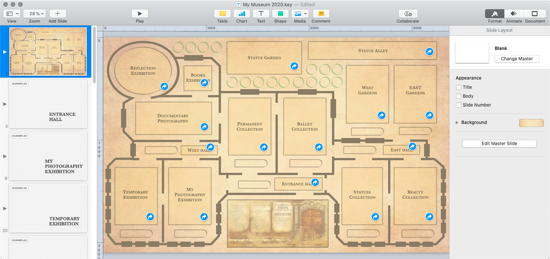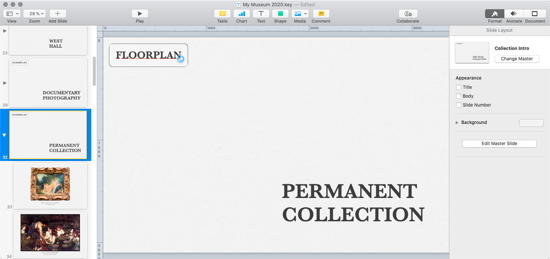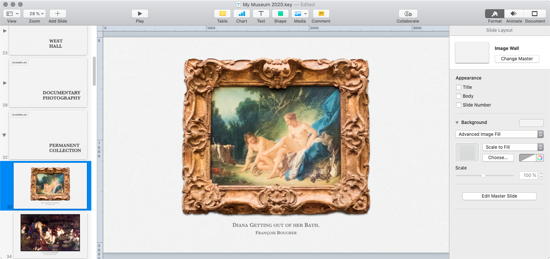Clarice Starling’s memory palace is building as well. It shares some rooms with Dr. Lecter’s own memory palace — he has discovered her in there several times — but her own palace grows on its own. It is full of new things. She can visit her father there. Hannah is at pasture there.
“Hannibal” by Thomas Harris
One of the beautiful elements of Harris’ “Hannibal” is Hannibal Lecter’s mind palace (book, not movie or series) and later Clarice Starling’s. He has this incredible palace in his mind, in which he can look, e.g., at artworks, or store memories (incl. very bad ones).
While that is likely out of reach for most people, a simpler virtual version is actually possible. And I would limit it to artworks, although you can easily store personal memories there as well.
Just make it virtual.
Probably the easiest way is in 2D using Keynote (or PowerPoint, if you’re a masochist without taste). Just draw a museum floor plan (copied mine mostly 1:1 from a Cthulhu game and redrew it in Keynote):

then add divider slides for the different museum rooms and create links to these slides (Keynote can do links to slides, just enter the slide number of the slide for the corresponding room, the numbers will automatically update when you add additional slides).

Then add slides for the (part of the) walls. I did use a photo of an actual museum wall as background.
Now the fun part — you can add the artworks.
There likely are some artwork you really like. For me, it’s, among others, “Diana getting out of her bath” (actually seen it in the Louvre in 2017) and Waterhouse’s “Hylas and the Nymphs” (still on my list, in Manchester, IIRC). But also lots of other semi-well known works.

You can add your own artworks, if you, e.g., draw, paint, or do photography.
You can also add more personal elements, for example, a portrait gallery of family members, or of current and former friends. Closer to the personal memory palace.
And yeah, at least with Keynote and the like you can also easily add videos and much more.
As for viewing — I am reminded of the movie “Collateral”. IIRC the taxi driver had a photo (of an island or so?) he used to look at for a few seconds to escape and have some peace of mind. I think you can use this virtual museum similarly.
Whenever you need a moment, just open the presentation (if possible, directly in show mode), and click on a room you want to visit. On fullscreen and with a modern monitor, you are essentially looking at a museum wall with a painting. Yeah, it’s not real, but then again, many museums do also exhibit “facsimilie” (or to use the non-fancy-smanzy term: fakes).
I’d suggest to watch only one or two in one sitting.
BTW, given that the whole thing is on your computer, you can also listen to music while watching. You can embed a music file, but it’s likely simpler to just select suiting music in the music app and go with it. (And listening to music in museums works really really well.)
And given Keynote (and likely PowerPoint) runs on mobile devices (well, Keynote runs on iOS devices, but seriously, what other devices are there ;-)), you can also watch them on your iPhone or iPad. Might be nice when you are on the road and you need a moment to escape. You can use “Shortcuts” to create an icon to immediately open the presentation in show mode.
All in all, I think it’s a nice idea. I did play around with it a little and I really like it. I have to put lots of paintings in the magazine (archive) to keep the rooms … tidy, but it works. Looking at it now, I think:
- a max limit of paintings depending on room size would have been good, then
- select images that might potentially fit in the museum (very best, you lose yourself in them), then
- sort the images to the rooms depending on a clear criteria like style or epoch (put them on the floor plan as thumbnails and sort them manually to the rooms), and finally
- put the images on the slides.
After all, the museum doesn’t have to hold everything. That’s what normal folders are for. Here it’s about the very best in a competitive limited space.